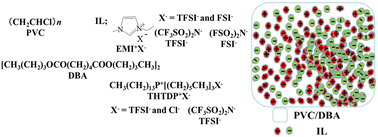High-performance transparent hybrid (ionic and dielectric) gel actuator system based on poly(vinyl chloride)/dibutyl adipate/ionic liquid gels operating at a low applied voltage†
Abstract
This study presents a transparent hybrid (ionic and dielectric) gel actuator system based on polyvinyl chloride (PVC) and ionic liquid (IL) gels with dibutyl adipate (DBA) as the plasticiser. The system operates at a low applied voltage (10–20 V), and the total transmittance at visible wavelengths (450–700 nm) is >85.5–88.5% for all IL species. The ionic conductivity of the gel depends on the IL species. The electrochemical and electromechanical properties are also investigated. The PVC/DBA/IL gel actuator is a hybrid (ionic and dielectric) gel actuator system, wherein the ionic gel actuator mechanism is dominant, while the PVC/DBA gel actuator is a dielectric gel actuator system. The maximum strain of the PVC/DBA/IL gel actuator under an applied square-wave voltage (±10 V) is 0.39% at 0.005 Hz, thus indicating that the PVC/DBA/IL gel actuators can generate sufficient strain for practical applications. These transparent, flexible, and robust gels have significant potential as actuator materials in wearable and transparent electronic and energy-conversion devices.

- This article is part of the themed collection: Multimodal Remote Actuation and Sensing in Polymers for Advanced Applications


 Please wait while we load your content...
Please wait while we load your content...